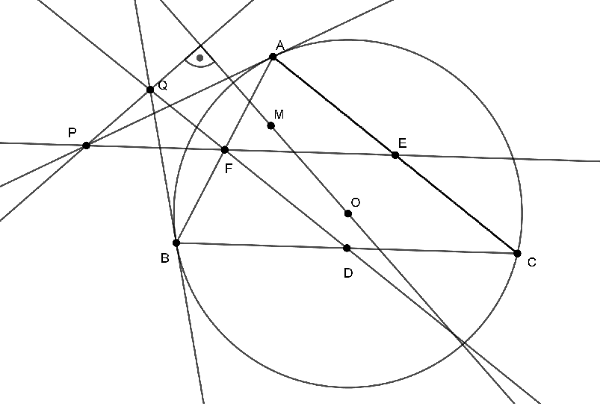 Problem B. 4995. (December 2018)
Problem B. 4995. (December 2018)
B. 4995. Let \(\displaystyle D\), \(\displaystyle E\) and \(\displaystyle F\), respectively, denote the midpoints of sides \(\displaystyle BC\), \(\displaystyle CA\) and \(\displaystyle AB\) of a right-angled but not isosceles triangle \(\displaystyle ABC\), let \(\displaystyle O\) be the centre of the circumscribed circle of the triangle, and let \(\displaystyle M\) be the orthocentre. The tangent drawn to the circumscribed circle at \(\displaystyle A\) intersects line \(\displaystyle EF\) at \(\displaystyle P\), and the tangent drawn at point \(\displaystyle B\) intersects line \(\displaystyle FD\) at \(\displaystyle Q\). Show that lines \(\displaystyle PQ\) and \(\displaystyle OM\) are perpendicular.
Proposed by B. Bíró, Eger
(5 pont)
Deadline expired on January 10, 2019.
Sorry, the solution is available only in Hungarian. Google translation
Megoldás. Az általánosság megszorítása nélkül feltehetjük, hogy \(\displaystyle ABC\) körülírt körének sugara \(\displaystyle 1\). Jelöljük az \(\displaystyle O\)-ból valamely pontba mutató vektort a megfelelő kisbetűvel, pl. \(\displaystyle \overrightarrow{OA}=\mathbf a\). A feltevés szerint \(\displaystyle |\mathbf a|=|\mathbf b|=|\mathbf c|=1\). A rövidebb írásmód kedvéért bevezetjük az \(\displaystyle x=\mathbf a \cdot \mathbf b\), \(\displaystyle y=\mathbf a \cdot \mathbf c\) és \(\displaystyle z=\mathbf b \cdot \mathbf c\) jelöléseket is. Itt jegyezzük meg, hogy valójában \(\displaystyle x=\cos 2\gamma\), \(\displaystyle y=\cos 2\beta\) és \(\displaystyle z=\cos 2\alpha\), ahol \(\displaystyle \alpha\), \(\displaystyle \beta\) és \(\displaystyle \gamma\) az \(\displaystyle ABC\) háromszög belső szögeit jelöli. Mivel a feltétel szerint \(\displaystyle ABC\) nem egyenlő szárú, így \(\displaystyle x\neq y\neq z \neq x\), ezt a számolás során folyamatosan használni fogjuk.

Mivel \(\displaystyle P\) illeszkedik az \(\displaystyle EF\) egyenesre, ezért valamilyen alkalmas \(\displaystyle \lambda\) valós számmal \(\displaystyle \mathbf p=\lambda \mathbf e+(1-\lambda) \mathbf f\). A felezőpontokra vonatkozó \(\displaystyle \mathbf e=(\mathbf a + \mathbf c)/2\) és \(\displaystyle \mathbf f=(\mathbf a + \mathbf b)/2\) összefüggésekből
\(\displaystyle 2\mathbf p=\mathbf a+ (1-\lambda) \mathbf b+\lambda \mathbf c.\)
Ebből \(\displaystyle 2\overrightarrow{AP}=2\mathbf p - 2\mathbf a=-\mathbf a+ (1-\lambda) \mathbf b+\lambda \mathbf c\). Mivel \(\displaystyle AP\) érinti a körülírt kört, így merőleges az \(\displaystyle OA\) sugárra, azaz \(\displaystyle \overrightarrow{AP}\cdot \overrightarrow{OA}=0\). Ebbe behelyettesítve a fenti formulákat:
\(\displaystyle 0=(-\mathbf a+ (1-\lambda) \mathbf b+\lambda \mathbf c)\cdot \mathbf a=-1+(1-\lambda)x+\lambda y.\)
Ebből pedig
\(\displaystyle \lambda=\frac{1-x}{y-x}.\)
A fenti számításokat megismételhetjük a \(\displaystyle Q\) pontra, amiből
\(\displaystyle 2\mathbf q=(1-\mu) \mathbf a+ \mathbf b+\mu \mathbf c,\)
ahol
\(\displaystyle \mu= \frac{1-x}{z-x}.\)
Jól ismert továbbá (lásd például Reiman I.: A geometria és határterületei, 3.3 szakasz), hogy \(\displaystyle \mathbf m=\mathbf a +\mathbf b+\mathbf c\).
Az eddigiek szerint (kényelmi okokból \(\displaystyle \overrightarrow{PQ}\) helyett \(\displaystyle 2\overrightarrow{PQ}\)-val számolva):
$$\begin{align*} \overrightarrow{OM}\cdot (2\overrightarrow{PQ})=\mathbf m \cdot (2\mathbf q-2\mathbf p)=\\ =(\mathbf a +\mathbf b+\mathbf c)\cdot ((1-\mu) \mathbf a+ \mathbf b+\mu \mathbf c-(\mathbf a+ (1-\lambda) \mathbf b+\lambda \mathbf c)=\\ =(\mathbf a +\mathbf b+\mathbf c)\cdot (-\mu \mathbf a+ \lambda \mathbf b+(\mu-\lambda) \mathbf c)=\\ =-\frac{1-x}{z-x}+\frac{1-x}{y-x} x+\left (\frac{1-x}{z-x}-\frac{1-x}{y-x}\right )y- \frac{1-x}{z-x} x+ \frac{1-x}{y-x}+\\ =\left (\frac{1-x}{z-x}-\frac{1-x}{y-x}\right )z - \frac{1-x}{z-x} y+ \frac{1-x}{y-x} z+\left (\frac{1-x}{z-x}-\frac{1-x}{y-x}\right )=\\ =\left (\frac{1-x}{y-x}- \frac{1-x}{z-x}\right ) x- \frac{1-x}{y-x} y + \frac{1-x}{z-x} z=\\ =(1-x)\frac{(z-x)x-(y-x)x-(z-x)y+(y-x)z}{(y-x)(z-x)}=0. \end{align*}$$Ebből pedig \(\displaystyle OM\perp PQ\) következik, ami éppen a bizonyítandó.
Megjegyzések.
1) Hasonlóan definiálható a \(\displaystyle C\)-ben vont érintő és a \(\displaystyle DE\) egyenes \(\displaystyle R\) metszéspontja. Az állításból következik, hogy \(\displaystyle P\), \(\displaystyle Q\) és \(\displaystyle R\) kollineárisak.
2) Ha \(\displaystyle ABC\) egyenlő oldalú, akkor a \(\displaystyle P\), \(\displaystyle Q\) és \(\displaystyle R\) pontok egyike sem jön létre. Ha \(\displaystyle ABC\) egyenlőszárú, de nem egyenlő oldalú, akkor a \(\displaystyle P\), \(\displaystyle Q\) és \(\displaystyle R\) pontok közül pontosan egy nem létezik, a meglévő kettőre az állítás igaz marad.
3) A bizonyításban sehol nem használtuk ki, hogy \(\displaystyle ABC\) hegyesszögű. Az állítás minden háromszögre igaz (feltéve, hogy \(\displaystyle P\) és \(\displaystyle Q\) létezik, lásd 2).
Statistics:
24 students sent a solution. 5 points: Beke Csongor, Fekete Richárd, Füredi Erik Benjámin, Geretovszky Anna, Győrffy Ágoston, Hegedűs Dániel, Jánosik Áron, Kerekes Anna, Nagy Nándor, Pooya Esmaeil Akhoondy, Rareș Polenciuc, Szabó 417 Dávid, Tiderenczl Dániel, Várkonyi Zsombor, Velich Nóra, Vladyslav Zveryk, Weisz Máté. 4 points: Baski Bence, Szabó 991 Kornél. 3 points: 2 students. 1 point: 3 students.
Problems in Mathematics of KöMaL, December 2018
